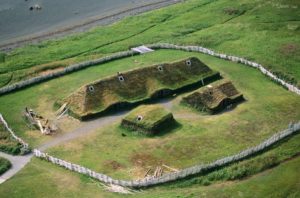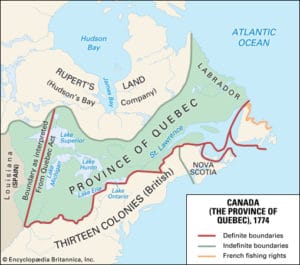
In 1583, Sir Humphrey Gilbert, by the royal prerogative of Queen Elizabeth I, founded St. John’s, Newfoundland, as the first North American English colony. French explorer Samuel de Champlain arrived in 1603 and established the first permanent European settlements at Port Royal (in 1605) and Quebec City (in 1608). Among the colonists of New France, Canadiens extensively settled the Saint Lawrence River valley and Acadians settled the present-day Maritimes, while fur traders and Catholic missionaries explored the Great Lakes, Hudson Bay, and the Mississippi watershed to Louisiana. The Beaver Wars broke out in the mid-17th century over control of the North American fur trade.
The English established additional settlements in Newfoundland, beginning in 1610 and the Thirteen Colonies to the south were founded soon after. A series of four wars erupted in colonial North America between 1689 and 1763; the later wars of the period constituted the North American theater of the Seven Years’ War. Mainland Nova Scotia came under British rule with the 1713 Treaty of Utrecht, and Canada and most of New France came under British rule in 1763 after the Seven Years’ War.
The Royal Proclamation of 1763 established First Nation treaty rights, created the Province of Quebec out of New France, and annexed Cape Breton Island to Nova Scotia. St. John’s Island (now Prince Edward Island) became a separate colony in 1769. To avert conflict in Quebec, the British Parliament passed the Quebec Act of 1774, expanding Quebec’s territory to the Great Lakes and Ohio Valley. More importantly, the Quebec Act afforded Quebec special autonomy and rights of self-administration at a time the Thirteen Colonies were increasingly agitating against British rule. It re-established the French language, Catholic faith, and French civil law there, staving off the growth of an independence movement in contrast to the Thirteen Colonies. The Proclamation and the Quebec Act in turn angered many residents of the Thirteen Colonies, further fueling anti-British sentiment in the years prior to the American Revolution.

After the successful American War of Independence, the 1783 Treaty of Paris recognized the independence of the newly formed United States and set the terms of peace, ceding British North American territories south of the Great Lakes to the new country. The American war of independence also caused a large out-migration of Loyalists, the settlers who had fought against American independence. Many moved to Canada, particularly Atlantic Canada, where their arrival changed the demographic distribution of the existing territories. New Brunswick was in turn split from Nova Scotia as part of a reorganization of Loyalist settlements in the Maritimes which led to the incorporation of Saint John, New Brunswick to become Canada’s first city. To accommodate the influx of English-speaking Loyalists in Central Canada, the Constitutional Act of 1791 divided the province of Canada into French-speaking Lower Canada (later Quebec) and English-speaking Upper Canada (later Ontario), granting each its own elected legislative assembly.
The Canadas were the main front in the War of 1812 between the United States and the United Kingdom. Peace came in 1815; no boundaries were changed. Immigration resumed at a higher level, with over 960,000 arrivals from Britain between 1815 and 1850. New arrivals included refugees escaping the Great Irish Famine as well as Gaelic-speaking Scots displaced by the Highland Clearances. Infectious diseases killed between 25 and 33 percent of Europeans who immigrated to Canada before 1891.
